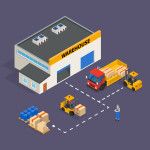Introduction
Retail operations serve as the backbone of any retail business, ensuring every aspect of the shopping experience runs smoothly. From the way products are sourced and displayed to how customers are served and payments are processed, efficient operations are what keep stores profitable and customers satisfied. This blog post will explore the concept of retail operations in detail, covering their meaning, importance, various types, and real-world examples. We’ll also dive into how retail operations can be automated to streamline processes, discuss different jobs within the field, and outline best practices to enhance efficiency.
What are Retail Operations?
Retail operations refer to the complete range of processes involved in managing a retail business, covering everything from the supply chain and inventory management to customer service and sales. These processes ensure that a business runs efficiently, creating value both for the company and its customers. Retail operations encompass multiple areas, including merchandising, logistics, store layout, employee management, and payment systems.
The 5S framework of retail operations offers a structured way to ensure effective organisation and management. Originally derived from Japanese lean manufacturing, the 5S principles have been adapted to retail settings as:
- Sort (Seiri) – Removing unnecessary products or items from the retail environment to avoid clutter and confusion.
- Set in Order (Seiton) – Organising products and operational tools for easy access and efficient workflows.
- Shine (Seiso) – Keeping the store clean, appealing, and safe for both customers and employees.
- Standardise (Seiketsu) – Implementing consistent processes across locations to ensure uniformity.
- Sustain (Shitsuke) – Maintaining the standards through continuous monitoring and improvement.
Following the 5S principles, businesses can establish a well-organised and streamlined retail environment.
Why Are Retail Operations Essential?
Retail operations are critical for both profitability and customer satisfaction. At the core of every successful retail business lies operational efficiency, which ensures that products are available, employees are prepared, and customers receive excellent service. Below are some key reasons why retail operations play a vital role:
1. Enhancing Customer Experience
Customer experience is at the heart of retail success. Effective retail operations ensure that customers have a positive and seamless shopping experience, from the moment they enter the store or visit an e-commerce site to the time they complete their purchase. Well-organised stores allow customers to find products easily, while efficient service reduces wait times. Elements such as knowledgeable staff, streamlined checkout processes, and easy returns contribute significantly to customer satisfaction.
A focus on retail operations can also lead to personalised shopping experiences. For instance, utilising customer data to tailor promotions or suggesting products based on previous purchases creates a deeper connection with consumers, making them more likely to return.
2. Optimising Inventory Management
Inventory management is a crucial aspect of retail operations that directly influences profitability. Properly managed inventory helps avoid stockouts, which can lead to lost sales, as well as overstock situations that tie up capital and increase holding costs. Retail operations provide the framework for effective inventory tracking, demand forecasting, and stock replenishment.
Utilising inventory management systems allows retailers to monitor stock levels in real time, identify fast-moving items, and adjust purchasing strategies accordingly. This optimization not only minimises costs but also ensures that customers find the products they want when they want them, enhancing their overall shopping experience.
3. Driving Cost Efficiency
Efficient retail operations reduce waste and operating costs, which are essential for maintaining healthy profit margins. Streamlined processes, such as automated inventory tracking or efficient supply chain logistics, can lower operational expenses by minimising manual errors and reducing labour costs.
For example, integrating technology such as Point of Sale (POS) systems can automate many transaction-related tasks, freeing up employees to focus on customer engagement and sales rather than administrative duties. This efficiency allows retailers to allocate resources more effectively, ultimately leading to improved profitability.
4. Ensuring Consistency Across Locations
Consistency is key for businesses with multiple locations or channels. Standardised retail operations ensure that customers receive the same level of service and product availability, regardless of the store they visit or the platform they use. This uniformity builds brand trust and customer loyalty, as consumers know what to expect from the brand.
Training programs, operational manuals, and centralised inventory systems help ensure that every location operates under the same guidelines. This consistency enhances the customer experience and makes it easier to implement new strategies or promotions across the business.
5. Facilitating Adaptability
The retail landscape is constantly evolving, influenced by changes in consumer behaviour, technology, and market trends. Effective retail operations enable businesses to respond swiftly to these changes. For instance, during peak shopping seasons, retail operations can adjust staffing levels and inventory to meet increased demand.
Moreover, operational flexibility allows retailers to pivot quickly in response to challenges, such as supply chain disruptions or shifts in consumer preferences. This adaptability is crucial for long-term sustainability, helping businesses stay relevant and competitive.
6. Supporting Data-Driven Decision Making
Retail operations generate valuable data about sales patterns, customer preferences, and inventory turnover. By analysing this data, retailers can make informed decisions that drive business growth. For example, sales analytics can reveal which products are underperforming, prompting necessary changes in inventory or marketing strategies.
Data-driven insights also help in identifying customer trends, enabling businesses to tailor their offerings more effectively. With access to real-time data, retailers can adjust pricing, promotions, and stock levels to better meet customer needs and maximise sales.
7. Building Strong Supplier Relationships
Retail operations extend beyond the store itself; they also encompass the relationships retailers maintain with suppliers. Effective operations facilitate clear communication and coordination with suppliers, ensuring that products are delivered on time and meet quality standards.
Strong supplier relationships lead to better negotiation terms, improved product availability, and collaboration on promotions or new product launches. This synergy not only enhances operational efficiency but also contributes to a more resilient supply chain.
8. Fostering Employee Engagement and Productivity
An organised and efficient retail operation creates a positive work environment for employees, which directly impacts their productivity and morale. When employees have clear processes to follow and the right tools at their disposal, they can perform their tasks more effectively.
Investing in training programs and technology empowers employees to excel in their roles, leading to better customer service and operational efficiency. Engaged employees who understand their roles in the broader retail operation are more likely to contribute positively to the business's success.
Retail operations are the key to balancing efficiency with customer satisfaction, creating an experience that brings customers back while maintaining healthy profit margins.
Retail Store Operations Types
Retail operations differ significantly based on the business model and sales channel. Each type of retail store operation has unique advantages and challenges that cater to specific customer needs. Here’s a breakdown of the most common retail operations types:
1. Brick-and-Mortar Retail
Traditional physical stores where customers visit to browse and purchase products. Examples include supermarkets, clothing boutiques, and department stores. These stores rely heavily on layout design, merchandising, and in-person customer service.
2. E-commerce
Online retailing where customers make purchases via websites or mobile apps. E-commerce relies on digital inventory management, order fulfilment, and payment processing systems. Examples include Amazon, Shopify stores, and other online marketplaces.
3. Pop-Up Stores
Temporary retail spaces designed to promote a brand or product for a short period. They are often used for seasonal sales or product launches. Pop-ups focus on creating engaging customer experiences within limited timeframes.
4. Franchise Stores
Retail outlets owned and operated by individuals or companies under a franchisor’s brand and guidelines. Examples include Starbucks or McDonald’s, where franchisees follow strict operational processes to ensure consistency across locations.
5. Mobile Retail
Retail operations occur through mobile units like food trucks or fashion stores. These operations focus on mobility, offering convenience by taking the product to customers instead of waiting for them to visit a store.
6. Catalogue Retail
A traditional form of retail where customers place orders through printed or online catalogues, with products delivered directly to their homes. This model has evolved into digital catalogues often integrated with e-commerce platforms.
Retail Store Operations Examples
Retail operations cover many activities essential to running a store efficiently. Below are key examples of retail operations that retailers manage daily:
1. Customer Service
Customer service is the frontline of retail operations, directly impacting customer satisfaction and loyalty. Exceptional customer service includes greeting customers as they enter the store, offering assistance with product selection, and addressing inquiries or concerns promptly.
Retailers can enhance customer service through training programs that equip employees with product knowledge and communication skills. For instance, a staff member at a clothing store may receive training on sizing, fabric types, and current fashion trends, enabling them to provide personalised recommendations. Additionally, implementing customer feedback systems, such as surveys or comment cards, helps retailers gather insights to improve service quality.
2. Store Management
Store management involves overseeing day-to-day operations to ensure the store runs smoothly. This includes managing staff schedules, monitoring sales performance, and maintaining inventory levels.
Effective store management utilises key performance indicators (KPIs) to assess operational efficiency. For example, a store manager may track metrics like sales per square foot, conversion rates, and average transaction values to identify areas for improvement. Regular staff meetings can facilitate communication, set goals, and foster teamwork, ensuring everyone is aligned with the store’s objectives.
KPI | Description |
Sales per Square Foot | Revenue generated per retail space |
Inventory Turnover Rate | Frequency of inventory sold annually |
Customer Satisfaction Score | Measure of customer service quality |
Employee Turnover Rate | Rate of staff leaving over time |
Average Transaction Value | Average amount spent per transaction |
Table: KPIs for effective store management
3. Inventory Management
Inventory management is crucial for maintaining optimal stock levels and minimising costs. Retailers must balance having enough inventory to meet customer demand while avoiding overstock situations that tie up capital.
A retail store can use inventory management software to automate tracking and reporting. For instance, when a product reaches a predetermined low stock level, the system can trigger a reorder from suppliers. This automated approach reduces the risk of stockouts and allows for better promotional event planning, ensuring sufficient stock for high-demand items.
4. Payments and Order Processing
Payment and order processing are critical to the retail transaction experience. Efficient point-of-sale (POS) systems streamline checkout processes, reducing wait times and enhancing customer satisfaction.
For example, a grocery store may implement a self-checkout option, allowing customers to independently scan and pay for their items. This speeds up the checkout process and frees up cashiers to assist with inquiries or restock shelves. Furthermore, retailers can utilise mobile payment options, such as digital wallets, to provide a convenient shopping experience, catering to the growing demand for contactless transactions.
5. Promotions and Pricing
Today's consumers are increasingly aware of prices. Although inflation has decreased since its highest point in 2022, 53% of shoppers cite rising prices and inflation as significant concerns, according to McKinsey.
That’s why strategic promotions and pricing strategies are essential for attracting customers and driving sales. To develop effective promotional campaigns, retailers must continuously assess market trends, competitor pricing, and consumer behaviour.
For instance, a seasonal sale can be promoted through various channels, including social media, email newsletters, and in-store signage. Additionally, retailers can implement dynamic pricing strategies, adjusting prices based on demand, competitor pricing, or inventory levels. For example, an electronics store may offer discounts on last season's models to make way for new inventory while ensuring that popular items remain competitively priced.
6. Supply Chain Management
Supply chain management ensures that products are delivered efficiently from suppliers to stores. This involves coordinating logistics, inventory levels, and supplier relationships to meet customer demand effectively.
For instance, a clothing retailer may work closely with suppliers to establish clear lead times and shipping schedules. Implementing just-in-time (JIT) inventory practices can help minimise excess stock while ensuring that new styles arrive in time for peak shopping seasons. Additionally, using technology, such as RFID tracking, enhances visibility throughout the supply chain, allowing retailers to monitor inventory levels and product movement in real time.
7. Order Fulfilment
Order fulfilment encompasses all steps from receiving an order to delivering the product to the customer. Efficient order fulfilment processes are essential for customer satisfaction, particularly in e-commerce.
For example, an online retailer may utilise a centralised warehouse where orders are picked, packed, and shipped directly to customers. Implementing automated picking systems can speed up the fulfilment process, while clear labelling and inventory organisation can reduce errors. Providing customers with real-time order tracking updates enhances their experience and builds trust in the retailer.
8. Employee Management
Effective employee management is crucial for maintaining a motivated and productive workforce. This includes recruiting, training, scheduling, and evaluating employees to ensure they meet performance standards.
Retailers can implement employee engagement programs to boost morale and reduce turnover rates. For example, offering incentives for meeting sales targets, conducting regular performance reviews, and providing opportunities for professional development can create a positive work environment. Additionally, scheduling software helps ensure adequate staffing levels during peak shopping times while respecting employees' work-life balance.
9. POS Operations
Point-of-sale (POS) operations are vital to retail transactions. They involve processing payments, managing customer data, and reporting sales. An efficient POS system can significantly enhance the overall shopping experience.
For instance, a restaurant may use a tablet-based POS system that allows servers to take orders and process payments at the table, speeding up service and reducing wait times. Integration with inventory management systems enables real-time updates on product availability, helping staff provide accurate information to customers.
10. Merchandising
Merchandising involves presenting products in a way that attracts customers and encourages purchases. Effective merchandising strategies include product placement, visual displays, and promotional signage.
For example, a grocery store might use eye-catching end-cap displays to promote seasonal items, like holiday treats or summer beverages. Retailers can also implement cross-merchandising techniques, placing complementary products together, such as chips and salsa, to encourage impulse purchases.
11. Store Layout and Design
Store layout and design play a critical role in shaping the customer journey within the retail space. An effective layout optimises product placement, enhances navigation, and creates an inviting atmosphere.
For instance, a clothing store might adopt a flow layout that guides customers through different sections, ensuring they encounter new arrivals and promotions along the way. Utilising lighting, colours, and signage effectively can enhance the shopping experience, making it easier for customers to find what they need and encouraging them to explore the store further.
12. Loss Prevention
Loss prevention strategies are essential for minimising theft and ensuring inventory accuracy. Retailers must implement various measures to protect their assets and reduce shrinkage.
For example, a store might employ security cameras, anti-theft devices, and employee training programs to deter shoplifting. Additionally, conducting regular inventory audits helps identify discrepancies and address potential issues proactively. Creating a culture of honesty and accountability among employees also plays a crucial role in loss prevention efforts.
These examples illustrate the multifaceted nature of retail store operations, highlighting the importance of each element in creating a successful retail environment. By focusing on customer service, inventory management, and various operational processes, retailers can enhance efficiency, drive sales, and build lasting relationships with customers. Embracing technology and best practices in these areas is essential for thriving in today’s competitive retail landscape.
How to Automate Retail Operations
1. Implement an Integrated Point of Sale (POS) System
A modern POS system serves as the backbone of retail operations, integrating sales, inventory management, and customer relationship management (CRM) into one platform.
Key Features:
- Sales Processing: Automate transactions with barcode scanning and digital payment processing, including mobile wallets and contactless payments.
- Inventory Management: Real-time inventory tracking allows automatic updates when sales occur, providing insights into stock levels and trends. Alerts can be set for low stock to trigger reorder processes.
- Customer Insights: Collect customer data during transactions, enabling targeted marketing and personalised shopping experiences.
Benefits: By utilising an integrated POS system, retailers can streamline checkout processes, reduce wait times, and enhance inventory accuracy, ultimately improving customer satisfaction and retention.
2. Utilise Inventory Management Software
Automating inventory management can significantly reduce the complexities of tracking stock levels, managing orders, and forecasting demand.
Features:
- Real-Time Tracking: Automated systems can monitor inventory levels continuously, providing insights into sales trends and stock movements.
- Automatic Reordering: Set thresholds for minimum stock levels that trigger automatic supplier reorders, ensuring optimal inventory without excess stock.
- Forecasting Tools: Leverage historical sales data to predict future inventory needs, helping to adjust purchasing decisions based on seasonal trends or sales promotions.
Benefits: These automated inventory management solutions help prevent stockouts and overstock situations, reduce holding costs, and improve cash flow.
3. Streamline Order Fulfilment Processes
Automating order fulfilment can enhance efficiency, especially for e-commerce operations, by simplifying the picking, packing, and shipping process.
Automation Techniques:
- Warehouse Management Systems (WMS): Implement a WMS to automate order processing, inventory tracking, and product organisation within the warehouse.
- Pick-to-Voice Technology: Utilise voice recognition systems that guide employees through the warehouse, indicating which items to pick and in what order, increasing picking accuracy and speed.
- Automated Packing Solutions: Invest in machines that can automatically pack products based on specific dimensions, reducing manual labour and minimising packaging waste.
Benefits: Automating these processes can lead to faster order fulfilment, reduced labour costs, and enhanced accuracy, improving the overall customer experience with quicker delivery times.
4. Adopt Customer Relationship Management (CRM) Systems
A CRM system helps manage customer interactions, track sales, and analyse customer data, ultimately improving customer service and loyalty.
Features:
- Personalised Marketing Campaigns: Automate email marketing campaigns based on customer behaviour, such as abandoned carts or previous purchases, to encourage repeat business.
- Customer Segmentation: Use automated tools to segment customers based on demographics or purchase history, allowing for targeted promotions that resonate with specific audiences.
- Feedback Collection: Automate the collection of customer feedback through surveys or follow-up emails, helping retailers gather valuable insights for improving service.
Benefits: By automating CRM processes, retailers can enhance their marketing efforts, improve customer engagement, and foster long-lasting relationships, leading to increased sales and loyalty.
5. Incorporate E-commerce Automation
For retailers operating online, automation can greatly enhance the shopping experience and streamline various processes.
Strategies:
- Chatbots and Virtual Assistants: Implement AI-driven chatbots on your website to handle customer inquiries, provide product recommendations, and assist with order tracking 24/7.
- Automated Inventory Updates: Synchronise inventory between online and physical stores automatically, ensuring customers see accurate stock availability, regardless of the shopping channel.
- Order Management Systems: Use automated systems to manage online orders, track shipments, and provide real-time updates to customers about their orders.
Benefits: These e-commerce automation strategies not only improve operational efficiency but also enhance customer satisfaction, as shoppers receive prompt responses and accurate information.
6. Utilise Workforce Management Tools
Automating workforce management can help retailers effectively schedule employees, manage labour costs, and enhance employee engagement.
Key Features:
- Automated Scheduling: Use software that automatically generates employee schedules based on availability, peak hours, and business needs.
- Time Tracking: Implement digital time clocks that allow employees to clock in and out easily, reducing errors associated with manual timekeeping.
- Performance Tracking: Utilise tools that monitor employee performance metrics, helping managers identify high performers and areas needing improvement.
Benefits: These workforce management tools ensure adequate staffing levels, reduce labour costs, and improve employee satisfaction by providing transparency and flexibility in scheduling.
7. Enhance Marketing Automation
Retailers can benefit significantly from automating their marketing efforts, allowing for targeted campaigns and increased efficiency.
Automation Techniques:
- Email Marketing Automation: Use platforms that enable automated email campaigns based on customer behaviour, such as welcome emails, birthday discounts, or re-engagement campaigns for inactive customers.
- Social Media Automation: Implement tools that schedule and manage social media posts, allowing retailers to maintain an active online presence without constant manual effort.
- Performance Analytics: Automate the collection and analysis of marketing data to evaluate campaign effectiveness, enabling retailers to adjust strategies based on real-time insights.
Benefits: Automating marketing processes helps retailers save time, enhance targeting, and measure the success of their campaigns, ultimately leading to better return on investment.
8. Integrate Supply Chain Automation
Streamlining the supply chain through automation can improve efficiency, reduce costs, and enhance responsiveness.
Strategies:
- Supplier Management Software: Automate communication and orders with suppliers, allowing for real-time updates on order statuses and reducing the risk of delays.
- Demand Planning Tools: Use software that forecasts demand based on historical data, seasonal trends, and market insights, helping retailers align their inventory with expected sales.
- Transportation Management Systems (TMS): Implement a TMS to optimise logistics and shipping processes, ensuring timely deliveries and cost-effective routing.
Benefits: By automating supply chain processes, retailers can enhance operational efficiency, reduce lead times, and improve supplier collaboration, leading to a more resilient supply chain.
9. Leverage Data Analytics for Insights
Automation in data analytics allows retailers to gather insights from various sources, leading to more informed decision-making.
Techniques:
- Sales Analytics Tools: Use automated reporting tools to gain insights into sales performance, customer preferences, and product trends, enabling data-driven decisions.
- Customer Behaviour Analytics: Analyse online and in-store customer behaviour to identify patterns, such as popular products or peak shopping times, allowing for targeted promotions and inventory planning.
- Operational Metrics Tracking: Automate the tracking of key operational metrics, such as shrinkage rates and employee performance, to identify areas for improvement.
Benefits: Automating data analytics enables retailers to access actionable insights quickly, improving responsiveness to market trends and customer needs.
10. Invest in Security Automation
Retailers must protect their assets and data, making security automation essential for safeguarding against theft and fraud.
Measures:
- Surveillance Systems: Implement automated surveillance cameras with real-time monitoring and alerts for suspicious activities.
- Access Control Systems: Use electronic access control for sensitive areas, such as stockrooms or cash offices, allowing automated tracking of employee access.
- Fraud Detection Software: Invest in software that monitors transactions for suspicious patterns, helping to identify potential fraud in real time.
Benefits: Security automation enhances overall safety and can significantly reduce losses due to theft or fraud, creating a more secure environment for both employees and customers.
Automating retail operations is a strategic move that can lead to significant improvements in efficiency, customer experience, and overall business performance. By implementing integrated systems across various operational areas, retailers can minimise manual workload, reduce errors, and gain valuable insights. Embracing automation is not just about keeping up with technological advancements; it’s about positioning the business for sustained growth and success in an increasingly competitive retail landscape. Through thoughtful automation strategies, retailers can focus on what truly matters—delivering exceptional value to their customers and fostering lasting relationships.
5 Retail Operations Jobs
The retail sector offers a diverse array of job opportunities, each playing a crucial role in ensuring smooth and efficient operations. As businesses continue to evolve, the demand for skilled professionals in retail operations grows, making it essential for individuals to understand the various roles and responsibilities within this field. Below are five key retail operations jobs, highlighting their significance, responsibilities, and the skills required for success.
1. Retail Operations Manager
Role Overview:
The Retail Operations Manager is responsible for overseeing the day-to-day operations of a retail store or a chain of stores. This role involves coordinating activities to ensure that the store meets sales goals, provides excellent customer service, and operates efficiently.
Key Responsibilities:
- Strategic Planning: Develop and implement operational strategies to achieve sales targets and enhance customer satisfaction.
- Team Leadership: Manage store staff, including hiring, training, and performance evaluations, to ensure a motivated and skilled workforce.
- Inventory Management: Monitor stock levels, conduct regular inventory audits, and implement effective replenishment processes to avoid stockouts or overstock situations.
- Customer Experience: Ensure high standards of customer service are maintained by training staff on best practices and resolving customer issues promptly.
- Budget Management: Oversee financial performance, manage operating budgets, and implement cost-control measures.
Skills Required:
- Strong leadership and team management skills
- Excellent communication and interpersonal abilities
- Analytical skills for data interpretation and decision-making
- Proficiency in inventory and financial management software
- Problem-solving skills to address operational challenges
2. Merchandising Manager
Role Overview
The Merchandising Manager is responsible for planning and executing product displays, promotions, and pricing strategies that drive sales and enhance the shopping experience. This role requires a keen eye for design and an understanding of customer preferences.
Key Responsibilities:
- Product Selection: Analyse market trends and customer data to select the right products for the store, ensuring alignment with consumer demand.
- Visual Merchandising: Develop visually appealing product displays that highlight key items and attract customers, ensuring that displays are regularly updated.
- Pricing Strategies: Collaborate with marketing and finance teams to establish competitive pricing strategies and promotional campaigns.
- Sales Analysis: Monitor sales performance for different products and categories, adjusting strategies based on performance metrics as needed.
- Supplier Coordination: Work with suppliers to negotiate terms and ensure timely delivery of products.
Skills Required:
- Strong creativity and visual design skills
- Excellent analytical abilities to interpret sales data
- Strong negotiation skills for supplier management
- Knowledge of retail software and inventory systems
- Strong communication skills for collaboration with various departments
3. Inventory Control Specialist
Role Overview
The Inventory Control Specialist is critical in managing stock levels and ensuring that inventory is accurately tracked and reported. This position is vital for minimising costs and optimising the supply chain.
Key Responsibilities:
- Inventory Tracking: Monitor inventory levels in real time, conducting regular audits to ensure accuracy and identify discrepancies.
- Reorder Management: Analyse sales patterns to determine reorder points, initiating purchase orders as necessary to maintain optimal stock levels.
- Data Analysis: Utilise inventory management software to analyse trends and generate reports on inventory performance.
- Loss Prevention: Implement strategies to reduce shrinkage and loss, collaborating with security teams to address theft or fraud.
- Collaboration: Work closely with suppliers and distribution centres to ensure timely deliveries and resolve inventory-related issues.
Skills Required:
- Detail-oriented with strong organisational skills
- Proficiency in inventory management software
- Strong analytical skills to interpret data and trends
- Effective communication skills for collaboration with team members and suppliers
- Problem-solving abilities to address inventory challenges
4. Customer Service Manager
Role Overview
The Customer Service Manager oversees customer service operations within a retail setting. This role focuses on enhancing the customer experience and ensuring that staff provides exceptional service.
Key Responsibilities:
- Team Management: Recruit, train, and supervise customer service representatives to deliver high-quality service.
- Customer Feedback: Monitor customer satisfaction through surveys and feedback, implementing improvements based on insights gathered.
- Issue Resolution: Address and resolve escalated customer complaints, ensuring a satisfactory resolution and maintaining customer loyalty.
- Service Training: Develop training programs that equip staff with the skills needed to handle customer inquiries and provide support effectively.
- Performance Monitoring: Analyse customer service metrics and adjust strategies to enhance service delivery.
Skills Required:
- Strong leadership and team-building skills
- Excellent communication and interpersonal skills
- Empathy and problem-solving abilities
- Ability to analyse customer feedback and implement changes
- Proficiency in customer service software and CRM systems
5. E-commerce Operations Coordinator
Role Overview
The E-commerce Operations Coordinator is responsible for managing online retail activities, ensuring that the e-commerce platform operates smoothly, and that customers have a positive online shopping experience.
Key Responsibilities:
- Website Management: Oversee the e-commerce website, ensuring that product listings are accurate, up-to-date, and optimised for search engines.
- Order Processing: Manage the order fulfilment process, coordinating with warehouses and logistics providers to ensure timely delivery.
- Customer Support: Provide online customer service, addressing inquiries related to orders, returns, and product information.
- Analytics Monitoring: Analyse website performance and sales metrics, identifying trends and areas for improvement.
- Marketing Collaboration: Work with marketing teams to implement online promotions and ensure alignment with overall marketing strategies.
Skills Required:
- Strong understanding of e-commerce platforms and digital marketing
- Excellent organisational and multitasking skills
- Proficiency in data analysis and e-commerce analytics tools
- Strong communication skills for customer interactions and team collaboration
- Problem-solving skills to address online shopping challenges
Retail operations jobs are essential to the success of any retail business, as they ensure that daily functions run smoothly while enhancing the customer experience. Each role offers unique challenges and opportunities, requiring a specific skill set and a commitment to excellence. As the retail landscape continues to evolve, professionals in these roles must adapt and innovate to meet the changing demands of consumers and the industry. By understanding the importance of these positions and the skills required, aspiring retail professionals can strategically position themselves for successful careers in this dynamic field.
Conclusion
Retail operations are the engine behind every successful retail business, ensuring that products are available, customers are satisfied, and processes run smoothly. Whether operating a brick-and-mortar store or an online platform, retailers must manage a complex set of activities, from inventory control to customer service and payments. Automating these operations helps improve efficiency, reduce costs, and enhance customer experiences. With various career opportunities and continuous innovation, retail operations remain a dynamic field that drives the success of businesses across the globe. By mastering these processes, retailers can stay competitive in a fast-evolving market, delivering value to customers and building long-term success.
To deepen your understanding and elevate your retail management skills, consider enrolling in our course, "Advanced Retail Management Strategies." This course provides insights into cutting-edge practices and innovative solutions for retail operations. Equip yourself with the tools and knowledge needed to thrive in today’s competitive retail environment.

























